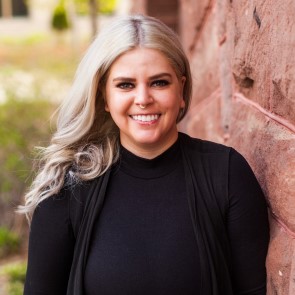
“Conversational Testimony: Performative Monologues, Vocal Palimpsests, and Virtual Holograms”
Professional Background
Dr. Kathryn Agnes Huether received her PhD in Musicology from the University of Minnesota, during which she was the recipient of the University of Minnesota’s Interdisciplinary Doctoral Fellowship and the Doctoral Dissertation Completion Fellowship, the Auschwitz Jewish Center Fellowship, and USHMM’s Summer Graduate Student Research Fellowship. Dr. Huether holds a second Master’s degree in Religious Studies from the University of Colorado, and a Bachelor’s in Violin Performance and Religious Studies from Montana State University.
Dr. Huether’s dissertation, “Centering the Sonic: Sound Mediation in Holocaust Memory, Memorials, and Museums,” examines Holocaust representation specifically for its sonic qualities, including musical undersocring, audio guides, vocal affect, and the sound of language. She is currently working on a chapter for the edited volume Visitor Experience at Holocaust Memorial Sites published by Routledge (2022), and has published work that examines visitor experience and audio guide engagement at the Treblinka memorial site in Poland. Dr. Huether has presented her research across the globe, including the special session of Lessons and Legacies in Munich, Germany (2019), the American Musicological Society, Yad Vashem’s International Workshop “Holocaust sources: truth, Interpretation, and (Mis)Use in the Digital Era,” and has been an invited speaker at Montana State University, University of Minnesota-Duluth, and the University of Toronto. Dr. Huether is an advocate for what she deems “practical musicology,” and strives to be a scholar who has a tangible impact on public discourse, informed by a far-ranging scope and approach that crosses over and into fields including, but not limited to: Holocaust studies, musicology, sound studies, cultural studies, Jewish studies, and German studies.
Fellowship Research
During her fellowship, Dr. Huether will continue her research on USHMM’s First Person program with the aspiration to develop a monograph on the program’s legacy. First Person began in 2000 and is a fascinating example of Holocaust testimony because of its over 20-year long run (and its continuation for the foreseeable future), and its consistency with the interviewed survivor. For example, survivor Fritz Gluckstein spoke on 18 occasions, beginning in the program’s second year. Gluckstein is just one example of the more than 100 individuals who have shared their stories. A close examination of these conversations illuminates how a testimony contains both consistency and variation from each retelling. Every program was recorded and is accessible via USHMM’s online collection, except the first two season programs of 2000 and 2001. A larger examination of First Person in its entirety will provide insight into how an individual’s testimony is molded, shaped, and varied from year to year, what newly emerges, and in regards to the human voice specifically, how we can literally hear the aging of the survivor.
